Shuttle XPC ST20G5
Overview
We've already covered the G5 chassis with our talk of the SN95G5, so there isn't a whole lot to say about the ST20G5. The basic idea is to take the same chassis and swap out the nForce 3 Ultra chipset and motherboard for a board that uses the ATI Xpress 200 chipset with a ULi 1573 South Bridge. Most areas remain the same, so we'll focus on the differences.Something that we would like to mention is that Shuttle now offers complete SFF systems through their online store as well as a variety of retail outlets. We've seen them at Best Buy, for example, although the local branch only carried an older Athlon XP model. Originally, the Shuttle XPCs were sold as a bare-bones system: case, motherboard, and power supply. Starting in 2004, Shuttle began offering complete systems. While you sacrifice some customization options, it does provide a ready-to-use alternative with a Shuttle warranty. Many of the upgrades end up costing quite a bit, but we see that for most companies that offer pre-configured systems. Those who do not want to build their own system can find more details at the Shuttle web site.
Aesthetics
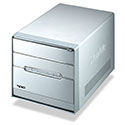 |
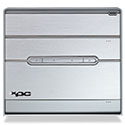 |
| Click on images to enlarge. | |
In terms of appearance, the ST20G5 is the exact same as the SN95G5 with one exception. Instead of a black anodized aluminum finish, the case is silver brushed aluminum. We don't have particularly strong feelings one way or the other, as they are both attractive. If you prefer silver over black, the ST20G5 meets that need. In an ideal world, users would be able to get whatever color case they wanted with any of the various models, but the reality is that getting a non-standard color will usually cost extra.
Features
|
Shuttle XPC ST20G5
|
||
| Dimensions | (w)200 mm x (h)185 mm x (d)310 mm | |
| CPU Support | AMD Socket 939 up to FX-57 X2 support currently Beta |
|
| Memory Support | PC1600/PC2100/PC2700/PC3200 up to 2GB; 2 DIMM slots | |
| Motherboard | FT20 (proprietary) ATI Radeon Xpress 200 (Northbridge) ULi 1573 (Southbridge) 1X-5X (200-1000MHz) HyperTransport 8-bit/8-bit to 16-bit/16-bit HT Width |
|
| Expansion Slots | 1 x PCIe X16; 1 x PCI | |
| Power Supply | 240W Silent X Power Supply 2 x 4-pin Molex; 1 x 4-pin FDD; 3 x SATA 1 x 4-pin ATX12V; 1 x 20-pin ATX |
|
| Internal Connections | 2 x SATA; 1 x IDE; 1 x FDD; 1 x LPT | |
| Audio | Realtek ALC880 7.1 channel HD | |
| LAN | 1 x 10/100/1000 Mbps (Broadcom PCIe) | |
| Drive Bays | 1 x 3.5 External (FDD/HDD) 1 x 3.5 Internal (HDD) 1 x 5.25 External (CD/DVD) |
|
| Front I/O | 2 x USB 2.0 1 x IEEE1394 (4pin) MIC, Head-phone Power & Reset buttons Power on & HDD LED indicators |
|
| Rear I/O |
1 x DVI, 1 x VGA 2 x USB 2.0 1 x IEEE1394 (6pin) PS/2 KB, PS/2 Mouse Serial port RJ-45 LAN Port (10/100/1000Mbps) S/PDIF In/Out Optical ports Line-in, Center/Sub, L/R Front, L/R Side, L/R Rear |
|
| Overclocking | CPU 200-255; CPU Ratio 4X-Max; Northbridge 1.60V-1.70V Vcc 0.800-1.700V; DDR Auto, 2.70-2.90V |
|
| Extras | ICE cooling | |
| Full Image Set | Shuttle ST20G5 Pictures (6.0MB) | |
| Manufacturer Link | Shuttle XPC ST20G5 | |
The feature list of the ST20G5 is similar to the SN95G5, with the obvious exception of the integrated graphics and PCI Express. Firewire, USB, GbE, audio, and S/PDIF are all present and accounted for. Internally, the layout is different and some of the features come from a different source (i.e. the network chip), but the basics remain the same. There are two DIMM slots, a PCIe X16 and PCI slot, two SATA and IDE connections, and a floppy connection. As usual, the G5 case includes two 3.5" drive bays, one internal and one external, along with a single external 5.25" bay up top.
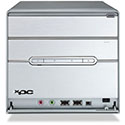 |
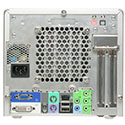 |
| Click on images to enlarge. | |
Let's talk a bit more about the differences, though. Where the nForce 3 Ultra powers the SN95G5 and provides a single chip solution, the ST20G5 uses a more traditional North Bridge/South Bridge arrangement. The ATI Xpress 200 is the NB and provides the PCI Express interface as well as a HyperTransport connection to the processor. For the SB, a ULi M1573 is used and it includes audio, USB, network, IDE/SATA, and PCI support. A PCI Express interface is used to connect to the NB, which helps to save on costs, since the NB already includes PCIe support. While the ULi chip includes a network controller, it is limited to 10/100 Mbit functionality and Shuttle has instead chosen to include a Broadcom GbE model. The Broadcom chip runs on the PCI Express bus (with an X1 interface), making it potentially faster than PCI GbE. We'll see how it compares later. The other major difference is that the ST20G5 uses PCI Express graphics like the SN25P, and here, we feel that the ST20G5 is the best configuration from Shuttle as it includes a PCIe X16 slot along with a standard PCI slot. In the future, X1 PCIe devices may become common, but right now, such slots go unused.
The integrated graphics are rather impressive, compared to competing solutions. Not only are they fully DirectX 9 compliant (with Shader Model 2.0 support), but they include a first for any integrated graphics that we've used: DVI output! Why does this matter? If you're interested in a SFF case for its looks, an LCD is a logical companion device. LCDs really aren't meant to be run with an analog VGA connection, as it results in poorer image quality. With the ATI Radeon Xpress 200 IGP, you get both the VGA connection as well as a DVI connection. DVI is also useful for connecting many HDTV displays to a computer. In our use, the TV was properly detected as a 1080i device. Unfortunately, it would only run at 1080i using the DVI connection. This is an ATI driver issue, as NVIDIA manages to support other resolutions (like 720p) through the DVI connection without any problem. We have heard from ATI that this will be addressed in an upcoming Catalyst release (5.7 may have already fixed this - we will check when we test the X2 chip).
Another interesting feature of the IGP is that it can be used concurrently with an add-in graphics card - although this only works with ATI models, as far as we're aware. ATI dubs this feature "Surround View" and it gives users the option of driving up to four separate display devices at the same time - two via the IGP and two via a supported add-in card. We're not sure how many people would actually purchase a SFF case with that intent, but the option is there should you need it. In the end, the Xpress 200 is the current leader in IGP solutions and offers much improved flexibility. Kudos goes to ATI for increasing IGP performance, and props to Shuttle for taking full advantage of the chipset.
The audio provided on the ST20G5 looks good on paper, and we're happy to see an HD solution (provided by the ULi chipset and a Realtek AL880 codec). This allows for 7.1 audio support, and though we think that 5.1 audio is more than sufficient, the additional audio ports do allow you to run 5.1 along with a microphone/line-in device. As with the SN95G5, all of the audio-out plugs are framed in the same green color, which can be a bit confusing. Green is usually used for the front speakers, with black/blue and orange/pink connections being typical for the center/sub and surround speakers. The colors are not exactly standardized, but the SN25P uses blue and orange for these connections. Shuttle should at least try to maintain a consistent color coding scheme with their designs, but it's not a big deal unless you plan to move your PC around frequently.
Unfortunately, while all of these audio specs should add up to a good experience, the end result was less than stellar. The front audio jack had very noticeable static, making it all but unusable. We also noticed some slight noise on a couple of the rear jacks, although it was border-line inaudible in our headphones and we couldn't hear it when using some Logitech X530 speakers. If crystal clear audio is a requirement for you, you may want to put the PCI slot to use with an add-in sound card. The other alternative is to use the S/PDIF out connection, which (like DVI) eliminates signal deterioration that often occurs with analog signals.
There are a few other concerns with the ST20G5 design. One of the first problems that we encountered was with our PowerColor X800Pro graphics card. It requires a separate 6-pin PCIe power adapter, and Shuttle neglected to include such a cable in the packaging. (So did PowerColor.) We had two spare 4-pin molex plugs available and were able to use an adapter, but this is an oversight on Shuttle's part. We're also uncertain as to whether or not the included PSU would be able to run with some of the higher end graphics cards, but as most of those are two-slot solutions, they will not fit inside the case either way. The power draw for the system at present was measured at 235W peak - basically, the rated maximum of the 240W PSU. We usually like a little breathing room, but we must say that we didn't experience any difficulties with the configuration at stock settings. 7800GTX support is going to be questionable, and that's something that we'll look into over the next couple of weeks. We would like to see the ST20G5 with an updated power supply that addresses the above concerns: a built-in PCIe power connection, and more power for running higher end cards. We have heard that they are planning to do just that for future SFFs, though whether a new PSU will ever make it into the ST20G5 is impossible to say right now.
Another complaint that we have is with the PCIe X16 retention mechanism. We've seen a variety of methods for securing the rear portion of the graphics card into the slot, and in our opinion, the Shuttle design is by far the worst. We mentioned this earlier in our return to the SN25P, and the ST20G5 uses the same plastic slot. Inserting a card is simple enough, but removing a card requires a lot more effort. Maybe if you have slender fingers, you could reach the rear of the slot and pry the plastic prongs apart, but it's really inconvenient. The Aopen sliding mechanism is the best that we've seen, as it can be easily accessed from either side. If you never have to remove your graphics card from the Shuttle slot, count yourself lucky. It's not the end of the world, but we're just surprised that they would depart from convention and choose something that is so clearly inferior to other solutions.
The comments about the lack of a flash reader and the limited expansion options that we discussed with the SN95G5 still apply here. If you really need a case with more expansion options, you'll have to look to one of the other SFFs in this roundup, or else stick with the standard ATX/uATX designs. That's a typical compromise that has to be made when choosing a SFF case, and many are happy to make the switch for the reduced noise levels and more attractive designs.


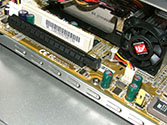








29 Comments
View All Comments
JarredWalton - Wednesday, August 10, 2005 - link
So I spoke too soon. After finishing this article, I just happend to come across http://www.newegg.com/Product/Product.asp?Item=N82...">the new Aopen 939 SFF. That actually looks pretty promising, though the IGP isn't going to beat the ST20G5 that I can see (no DVI port). Time to put in a request for that unit....rqle - Wednesday, August 10, 2005 - link
Price of these SFF are getting quite pricey lately. So much to the point when you add the cpu, hard drive, memory, video card, optical drive AND LCD it will comes very close to the price of a good high end laptop on a good day. Dell 17inch 9300 w/6800 on a VERY good sale day comes just over the price of these SFF 'system.' Big fan of these SFF, but prices should be a little bit more reasonable for me to buy again.JarredWalton - Wednesday, August 10, 2005 - link
I agree with you on a lot of that, but a SFF with a 19" (or larger) LCD and a 6800GT/X800XL is pretty much going to stomp all over any similarly priced laptop. There's basically a $150 price premium to get a high-end SFF case, which is going to prevent many from buying. Still, some people buy $200 cases just because they look nice, so it's all a matter of taste.If you need portability, though, there are very few options other than getting a laptop. Personally, laptops and gaming are something I just don't care about. I'd get a cheap laptop for the office work I do and then keep a second system at home for any gaming. Some of course feel otherwise, but laptop keyboards and such just don't do it for me.
R3MF - Wednesday, August 10, 2005 - link
love it.BigT383 - Wednesday, August 10, 2005 - link
I have a first-generation SN95G5. I bought it thinking that since it's socket 939 I'd be able to upgrade to dual-core when it came out.Apparently this isn't the case, but I haven't seen anybody say they've tried it yet- so far there seem to be only rumors.
So I know this is a weird request but what I'd like to see right now is an article testing a CPU like the Athlon X2 4400+ on the three different versions of the SN95G5.
I can understand that X2s need a bios update, but the physical motherboard shouldn't be holding me back, right?
dcuccia - Thursday, August 18, 2005 - link
X2 support for the SN25P w/o USB2 issues is now available through a BIOS upgrade:http://www.shuttle.com/share/fae/hq/download/bios_...">http://www.shuttle.com/share/fae/hq/download/bios_...
JarredWalton - Thursday, August 18, 2005 - link
Thanks, I made a quick comment on the SN25P page to mention this.JarredWalton - Wednesday, August 10, 2005 - link
I'm going to be dropping an X2 3800+ into the SN95G5v2 just to see what happens. I'll try to get some official word from Shuttle on the matter as well. I really have no idea what the SN95G5v1 will support. I think the main change between it and v2 was a switch from an 80mm fan to a 92mm fan.Zirconium - Wednesday, August 10, 2005 - link
I love the roundup articles. I find them to be the most useful because they allow you to hone in on what you are looking for quickly, and then you can go to other sites and check the reviews that are solely for the products you are looking for.That said, one thing I'm interested is the quality of the integrated graphics on these computers. I have an SK41G and I could tell the difference between the quality of the built-in graphics and the AIW Radeon 7500 that is currently in it. When the integrated graphics were hooked up to a TV (I tried two) you could notice bands moving up the TV.